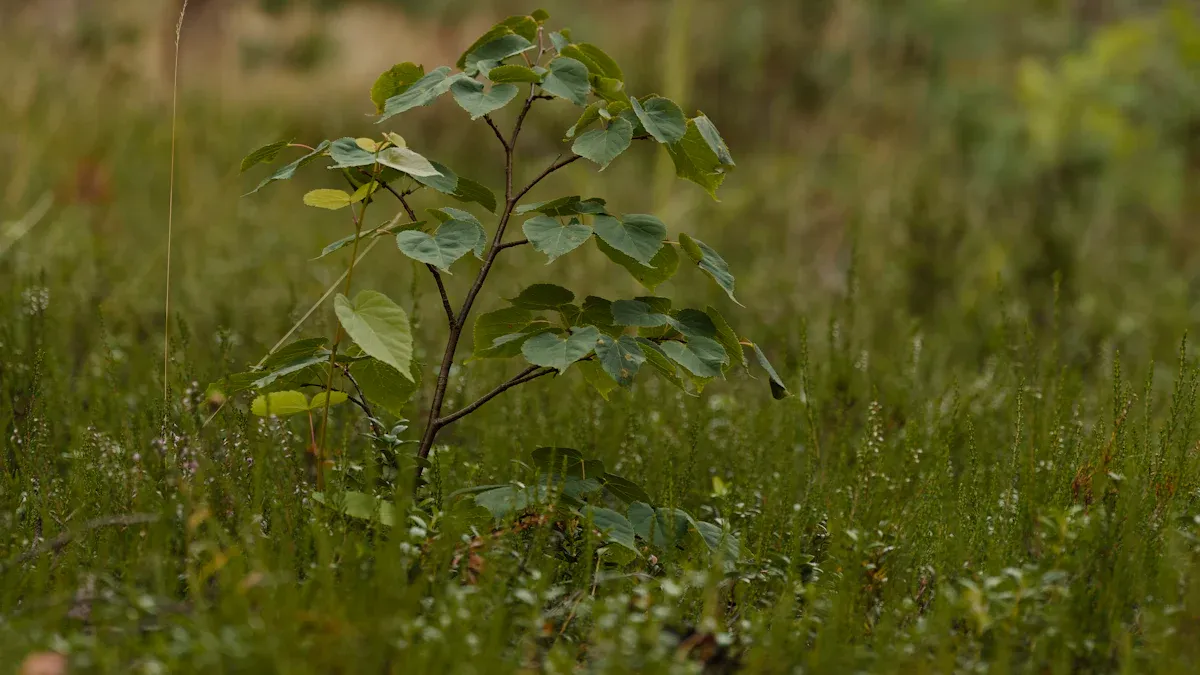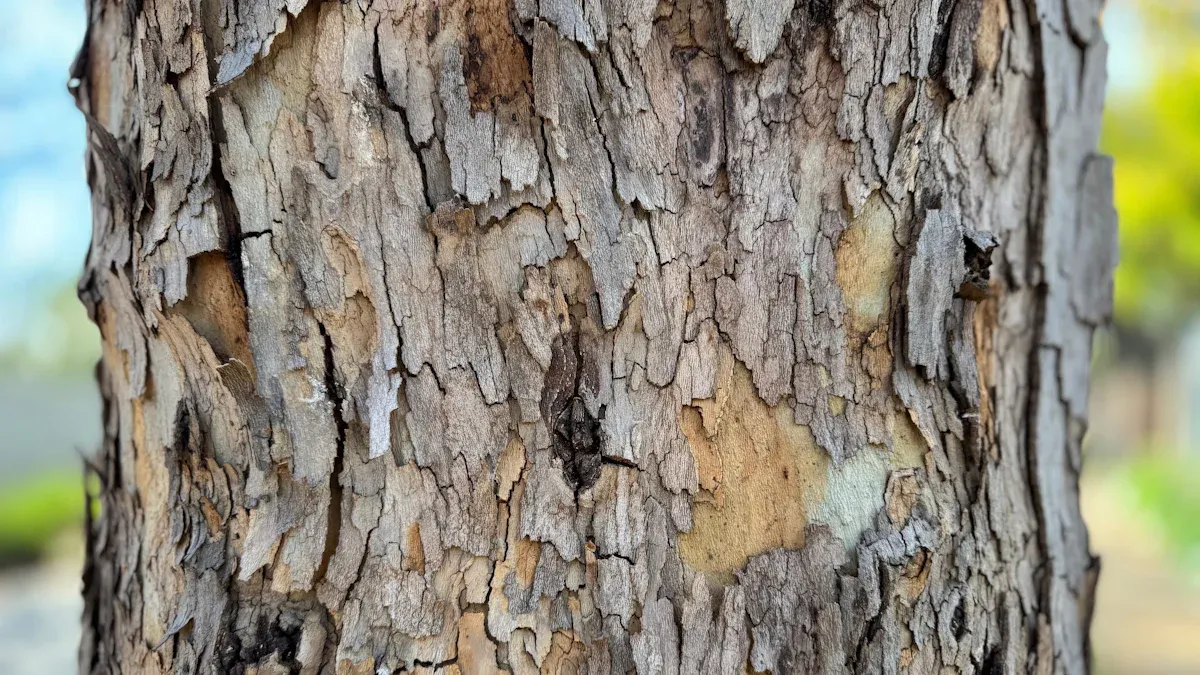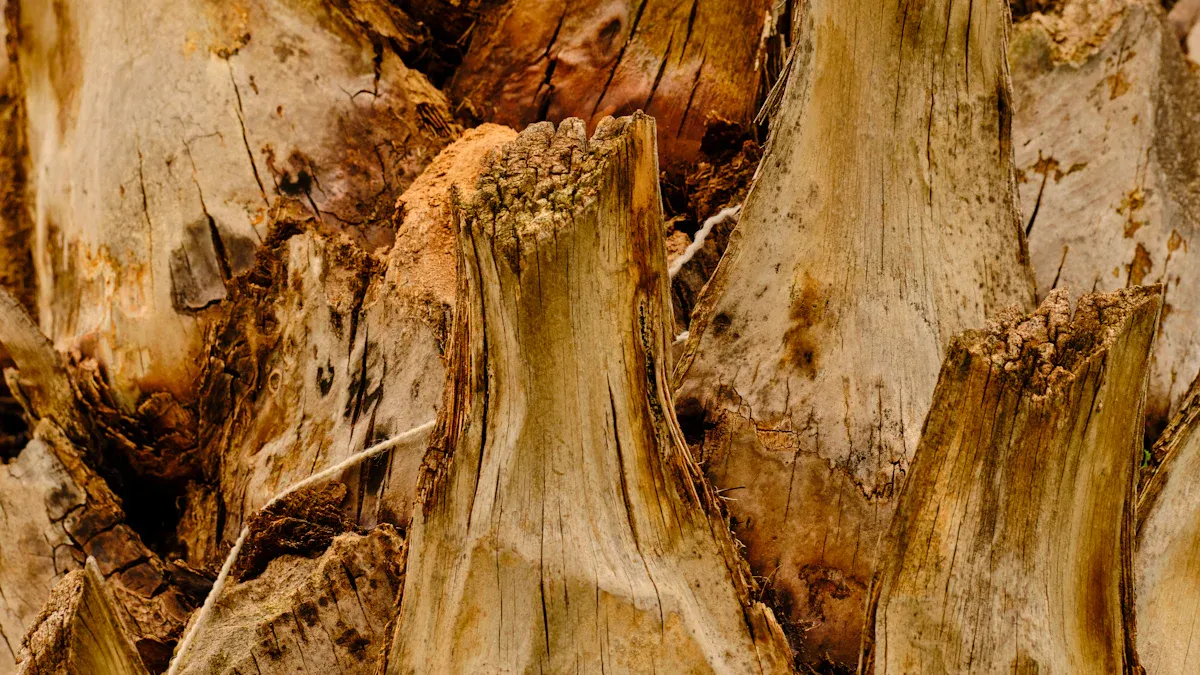
Yes, tree bark can regenerate after damage. This remarkable ability showcases the resilience of trees. Bark plays a crucial role in protecting trees from pests, diseases, and environmental stressors. It also helps transport essential nutrients throughout the tree. Understanding the science behind bark regeneration reveals how trees maintain their health and thrive despite challenges.
Key Takeaways
Bark protects trees from pests, diseases, and environmental stressors, acting like skin for trees.
Trees can heal wounds by forming callus tissue, which eventually turns into new bark, helping them recover from damage.
Different tree species have varying abilities to regenerate bark, with some like willows and poplars healing faster due to their genetics.
Environmental factors such as temperature and humidity significantly influence how well trees recover their bark after damage.
Proper tree care, including timely wound treatment and adequate nutrients, supports healthy bark regeneration and tree resilience.
The Role of Bark in Tree Health

Protective Functions of Bark
Bark serves as a vital shield for trees, protecting them from various threats. Just like your skin protects your body, bark guards trees against pests, diseases, and environmental stressors. Here are some key protective functions of bark:
Defense Against Pathogens: Bark acts as a barrier against harmful microorganisms. It contains antimicrobial properties that help prevent infections. For instance, bark extracts from common European trees show potential as sources of antimicrobial compounds. These extracts can inhibit the growth of pathogens, much like how your skin fights off bacteria.
Physical Protection: Bark protects trees from physical injuries. When trees experience damage, they respond by converting stored sugars into defensive chemicals. These chemicals help seal wounds and prevent decay. The CODIT (compartmentalization of decay in trees) method allows trees to create chemical walls around damaged areas, isolating decay and promoting healing.
Resistance to Herbivores: Trees have evolved various defenses against herbivores. Bark can release harmful substances, such as phenols and terpenoids, which deter animals from feeding on them. Additionally, thick bark provides mechanical resistance, making it harder for animals to penetrate.
The protective functions of bark extend beyond just fire protection. Bark also supports trees mechanically and stores essential substances, reflecting the diverse roles it plays in tree health.
Nutrient Transport
Bark plays a crucial role in transporting nutrients throughout the tree. It is not just a protective layer; it also facilitates the movement of vital resources. Here’s how bark contributes to nutrient transport:
Nutrient Cycling: Recent studies show that bark can modify water chemistry, affecting nutrient uptake. In some forests, researchers found that bark absorbs nutrients like calcium, potassium, and zinc from the environment. This process helps trees maintain their nutrient balance.
Stemflow Dynamics: During rainfall, water flows down the bark, a process known as stemflow. In a Belgian oak forest, scientists observed that stemflow contained lower concentrations of nitrate and ammonium compared to rainfall. This indicates that bark actively participates in nutrient uptake during the leaf-off season.
Direct Uptake: The ability of bark to directly absorb water and nutrients may be more significant than previously thought. As trees transpire, they can leach nutrients from the xylem, which can then be redeposited on the bark surface, enhancing nutrient availability.
Bark’s role in nutrient transport is essential for overall tree health. It ensures that trees receive the necessary nutrients to grow and thrive, much like how your skin health depends on proper nutrition.
Types of Damage and Wound Healing
Natural Causes of Damage
Trees face various natural threats that can damage their bark. Understanding these causes helps you appreciate the resilience of trees. Here are some common natural causes of bark damage:
Source | Findings |
|---|---|
Andreev (1988) | Discusses the ten-year cycle of winter grouse and its impact on bark stripping behavior. |
Baxter and Hansson (2001) | Reviews bark consumption by small rodents in various hemispheres. |
Gill (1992a) | Analyzes damage by deer in north temperate forests. |
Klich (2017) | Examines selective bark stripping by Polish horses. |
Mansson and Jarnemo (2013) | Investigates bark stripping by red deer in relation to tree characteristics. |
Motta (1996) | Studies the impact of wild ungulates on forest regeneration. |
Silcock (2018) | Discusses findings from the coast redwood science symposium. |
These studies show that animals like deer and rodents can strip bark, leading to significant damage. Such injuries can hinder the tree’s ability to heal and regenerate.
Human-Induced Damage
Human activities also contribute to bark damage. You might not realize how your actions can affect trees. Here are some common ways humans damage tree bark:
Soil compaction from foot traffic can harm tree roots, making them more vulnerable to diseases.
Carvings on trees often occur near trails with high human traffic, indicating a direct link between human activity and bark damage.
Beech trees are particularly affected by physical damage, which can lead to conditions like Beech Bark Disease (BBD).
These factors can significantly impact a tree’s health and its ability to recover from injuries.
Wound healing in trees involves several physiological stages. When a tree sustains damage, it initiates a process to heal itself. The first stage is callus formation, where tissue develops at the wound site. This tissue eventually differentiates into new xylem, phloem, and outer bark. The closure time varies based on the wound size and tree species. Smaller wounds may close within weeks, while larger ones take longer. Seasonal activity also plays a role, as callus growth peaks during warmer months.
Understanding these processes helps you recognize the importance of caring for trees. By minimizing damage, you can support their natural wound healing and regeneration.
Bark Regeneration Process

Biological Mechanisms
Bark regeneration involves several complex biological mechanisms at the cellular level. When a tree sustains damage, it activates specific processes to heal and restore its bark. Here are some key mechanisms involved in bark regeneration:
Mechanism Type | Description |
|---|---|
Cambium Reconstruction | Phloem and cambium are reconstituted from xylem cells after bark removal. |
Gene Expression Changes | Differentially expressed genes (DEGs) such as Aux/IAA and PIN are highly expressed during cambium establishment. |
Protein Expression | Proteins involved in metabolism, signaling, and cell cycle are highly expressed during cambium re-establishment. |
miRNA Regulation | 21 known and 30 novel miRNA families are dynamically expressed, affecting auxin signaling and cell differentiation. |
These mechanisms work together to ensure that trees can effectively regenerate their bark after injury. The cambium layer, which is responsible for producing new bark, plays a crucial role in this process. As the tree heals, it re-establishes its protective outer layer, allowing it to fend off pests and diseases.
Rapid Regeneration in Species
Some tree species exhibit remarkable capabilities for rapid bark regeneration. This ability can vary significantly among different species. For example, certain willows and poplars can regenerate bark quickly due to their unique genetic makeup. Here are some genetic factors that influence bark regeneration:
Genetic Factors | Role in Bark Regeneration |
|---|---|
Auxin transport genes | Establish auxin gradient for phloem and cambium recovery |
PttLAX2, PttLAX3, PttPIN1 | Expressed abundantly in regenerating cambium |
APL, KAN, Dof | Promote repatterning of hormone distribution |
CLV1, CLV2, ANT1, SHR, SCR | Involved in cambium specific gene activation |
Epigenetic changes | Allow xylem cells to acquire competence for regeneration |
These genetic factors help trees respond quickly to damage, enabling them to restore their bark efficiently. For instance, studies show that when a tree generates a new periderm with at least three suberized phellem cells around a wound, it becomes less susceptible to fungal infections. This highlights the importance of bark regeneration in maintaining tree health and resilience.
When tree bark is wounded, a series of complex biochemical events is initiated. Under ideal conditions, these events lead to the generation of new bark. The primary ligno-suberized layer is crucial because it provides the internal conditions necessary for the formation of the new bark or periderm. Disease resistance via periderm formation occurs because the periderm forms a structural barrier to pathogen ingress.
Understanding these biological mechanisms and the rapid regeneration capabilities of certain species can help you appreciate the resilience of trees. By recognizing how trees heal, you can take better care of them and support their natural processes.
Factors Influencing Bark Recovery
Environmental Conditions
Environmental conditions play a significant role in how well trees recover their bark after damage. Factors such as temperature, humidity, and light can greatly influence the recovery rates. Here’s a closer look at how these conditions affect bark recovery:
Environmental Condition | Measurement | Effect on Bark Transpiration Rate |
|---|---|---|
Air Temperature | Highest at midday from July to September | Influences transpiration dynamics |
Ambient VPD | Maximum at noon in July and August (3.3–3.4 kPa) | Affects bark transpiration rates |
Nighttime Conditions | Negative transpiration observed | Indicates water uptake during night |
As you can see, higher temperatures can enhance transpiration, which is crucial for nutrient transport and overall tree health. Conversely, nighttime conditions can hinder water uptake, affecting the tree’s ability to recover.
Species-Specific Recovery
Different tree species exhibit varying abilities to recover from bark damage. Some species are more resilient than others, and this resilience can depend on several factors, including genetic makeup and environmental adaptations. Here’s a comparison of recovery characteristics among different tree species:
Tree Species | Recovery Characteristics | Damage Comparison |
|---|---|---|
Betula | Lower density of seedlings, greater proportion of surviving canopy trees | Less damage from 1994 disturbance |
Sprouts and seedlings survived in understory | Smaller pit and mound microsites compared to 1985 disturbance |
This table highlights how Betula trees manage to survive better than others after disturbances. Their ability to sprout and maintain canopy trees shows their resilience.
Additionally, the age and maturity of trees also influence their recovery capabilities. Older trees tend to have thicker bark, which provides better protection against frost damage. Here’s a summary of how tree age affects bark recovery:
Evidence Description | Findings |
|---|---|
Bark thickness increases with tree age | Older trees have thicker bark, providing better protection to the cambium against frost damage. |
Relationship between bark thickness and frost ring probability | As bark thickness and cambial age increase, the probability of frost rings decreases, indicating better regeneration capabilities. |
You can see that older trees not only have thicker bark but also demonstrate improved regeneration abilities.
Moreover, bark extracts from various woody vascular plants can significantly aid in the healing process. These extracts are rich in polyphenols and minerals, which possess antioxidative properties. They help reduce swelling and promote recovery, making them beneficial for trees after injury. Here are some key points about bark extracts:
Bark extracts contain significant chemical compositions that aid in healing processes.
They are rich in polyphenols and minerals, which possess antioxidant and immunostimulatory properties.
These properties may contribute to reducing swelling and promoting recovery.
Understanding these factors can help you appreciate the complexity of bark recovery. By recognizing the environmental conditions and species-specific traits that influence recovery, you can take better care of trees in your environment.
Caring for Trees to Promote Bark Health
Best Practices for Tree Care
To promote bark health, you should follow several best practices. These practices help trees heal effectively and maintain their resilience. Here are some key recommendations:
Timing Matters: Wound closure in trees, especially in species like Prunus persica, is most effective from mid-winter to summer. During this time, sap flow is high, which promotes faster healing. Warmer temperatures enhance callus production, so aim to address wounds during these months.
Proper Treatment Techniques: Always use appropriate methods when caring for trees. Improper techniques can harm trees significantly. Healthy trees maintain high starch levels, which help them fight off infections. If starch levels drop, trees struggle to seal wounds, making them vulnerable to diseases.
Nutrient and Water Supply: Provide the right nutrients and water to support healing. Healthy trees need these resources to recover effectively. Monitor for pests and diseases that could affect recovery, and prune infected areas promptly to prevent disease spread.
Avoid Outdated Practices: Do not use wound dressings. Trees have natural defense mechanisms that help them heal. Applying dressings can actually slow down the process of sealing wounds with new tissue.
Signs of Healthy Recovery
Recognizing the signs of healthy bark recovery is essential for effective tree care. Here are some indicators that your tree is healing well:
New Growth: Look for signs of new growth around the wound area. This indicates that the tree is actively producing new tissue.
Callus Formation: A healthy callus forms over the wound. This tissue helps seal the injury and protects against pathogens.
Color Changes: Observe the color of the bark. Healthy bark should appear vibrant and free from discoloration or lesions.
Increased Sap Flow: If you notice increased sap flow, it suggests that the tree is actively working to heal itself.
By following these best practices and recognizing signs of recovery, you can help your trees thrive and maintain their bark health. Your efforts will contribute to their resilience against future challenges.
Understanding bark regeneration is vital for tree health. You learned that bark protects trees and aids in nutrient transport. Early identification of bark damage can prevent severe issues. Here are some key takeaways from recent research:
Key Takeaway | Description |
|---|---|
Bark as a Resource | Bark has great potential for sustainable product development, including biobased plastics. |
Resilience of Norway Spruce | Bark stripping has negligible short-term effects on the growth of Norway spruce, indicating resilience. |
Ecological Impacts | Over-exploitation of bark can harm natural regeneration and wildlife habitats. |
Therapeutic Properties | Bark extracts show promise in modern phytotherapy for treating oxidative stress and infections. |
By following best practices in tree care, you can support their recovery and resilience. Your proactive steps will help ensure the health of trees in your environment.
FAQ
What is bark regeneration?
Bark regeneration is the process by which trees heal and restore their protective outer layer after damage. This process involves complex biological mechanisms that allow trees to recover from wounds and maintain their health.
How long does bark take to regenerate?
The time it takes for bark to regenerate varies by species and wound size. Smaller wounds may heal within weeks, while larger wounds can take months or even years to fully close.
Can all tree species regenerate bark?
Not all tree species regenerate bark at the same rate. Some species, like willows and poplars, exhibit rapid regeneration, while others may heal more slowly due to genetic and environmental factors.
How can I help my tree recover from bark damage?
To help your tree recover, ensure it receives adequate water and nutrients. Avoid damaging the bark further, and monitor for pests or diseases. Prune any infected areas promptly to support healing.
What are signs of healthy bark recovery?
Signs of healthy bark recovery include new growth around the wound, callus formation, vibrant bark color, and increased sap flow. These indicators show that your tree is actively healing and restoring its protective layer.

